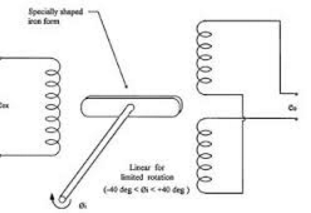Construction and working of RVDT (Rotary variable differential transformer)
The RVDT stand for rotary variable differential transformer is used to sense the angular displacement. It is similar to LVDT except that its core is in cam shaped and moves between the windings by means of shaft.
Construction
The basic construction of RVDT is shown in above fig. The RVDT consists of one primary winding and two secondary windings. The emf induced in the secondary winding is a function of rotary displacement. The both secondary windings are placed in such a way to produce emf 180 degree out of phase to each other.
Working
The working of RVDT is similar to that of LVDT. According to movement of the shaft, three differential conditions are formed.
Condition 1:
When shaft is at null position as shown in above fig, the emf induced in both the secondary windings are equal but opposite in phase. Therefore, the differential output potential is zero.
E1 = E2
E0 = E1-E2 = 0
Condition 2:
When the shaft moves in clockwise direction, more portion of the core comes across the winding S1. Hence, the emf induced across the coil S1 is more than S2. The differential output potential is positive.
E1 > E2
E0 = E1-E2 = positive
Condition 3:
When shaft moves in anticlockwise direction, more portion of the core comes across the winding S2. Hence, the emf induced across the coil S2 is more as compared to S1. Therefore, the differential output potential shows 180 degree phase shift i.e. negative.
E1 < E2
E0 =E1-E2 = negative


